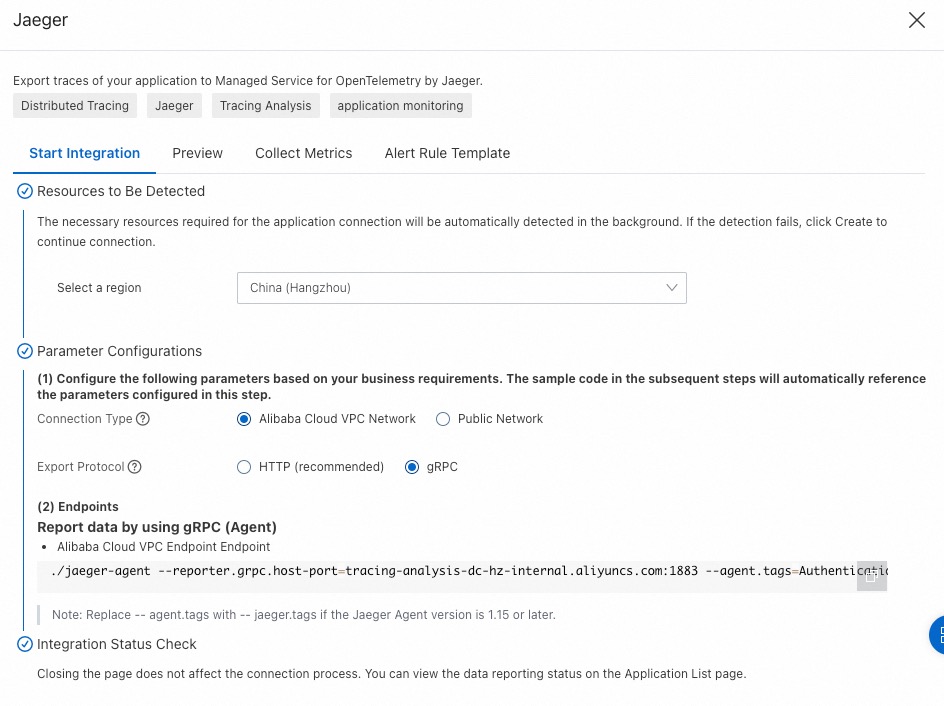Managed Service for OpenTelemetry allows you to use OpenTelemetry, Jaeger, Zipkin, and SkyWalking clients to report application trace data to the console. This topic describes how to install the Jaeger agent.
Step 1: Obtain an endpoint
New console
Log on to the Managed Service for OpenTelemetry console. In the left-side navigation pane, click Integration Center.
On the Integration Center page, click the Jaeger card in the Open Source Frameworks section.
In the Jaeger panel, click the Start Integration tab, and then select a region in which you want to report data.
NoteResources are automatically initialized in the region that you access for the first time.
Configure the Connection Type and Export Protocol parameters and copy an endpoint.
Connection Type: If your service is deployed on Alibaba Cloud and resides in the region that you selected, we recommend that you set this parameter to Alibaba Cloud VPC Network. Otherwise, set this parameter to Public Network.
Export Protocol: Set this parameter to gRPC based on the protocol that is supported by the client.

Old console
Log on to the Managed Service for OpenTelemetry console.
In the left-side navigation pane, click Cluster Configurations. On the page that appears, click the Access point information tab.
In the top navigation bar, select a region in which you want to report data. In the Cluster Information section, turn on Show Token.
Set the Client parameter to Jaeger.
In the Related Information column of the table, copy an endpoint.
 Note
NoteIf your application is deployed in an Alibaba Cloud production environment, use a VPC endpoint. Otherwise, use a public endpoint.
Step 2: Download and start the Jaeger agent
ECS clusters
If your application is deployed in an Elastic Compute Service (ECS) cluster, you can start the Jaeger agent by performing the following operations:
Download and decompress the installation package of the Jaeger agent.
NoteRun the following command to start the Jaeger agent:
nohup ./jaeger-agent --reporter.grpc.host-port=<endpoint> --agent.tags=<token>
Docker containers
If your application is deployed in a Docker container, we recommend that you start the Jaeger agent by running the docker run command. This reduces your O&M costs. Run the following command to start the Jaeger agent:
docker run -d\
--rm \
-p5775:5775/udp \
-p6831:6831/udp \
-p6832:6832/udp \
-p5778:5778/tcp \
jaegertracing/jaeger-agent:<version> \
--reporter.grpc.host-port=<endpoint> \
--agent.tags=<token>Perform the following operations on the parameters in the docker run command:
If your Jaeger agent is of V1.15.0 or an earlier version, replace
--agent.tagswith--jaeger.tags.Replace
<version>with the version of the Jaeger agent, such as 1.23. For more information about other available versions, visit jaegertracing/jaeger-agent.Replace
<endpoint>with the endpoint that you obtained in Step 1.Replace
<token>with the token that you obtained in Step 1.